Skunks have a very long love/hate relationship with humans. Considered a symbol of love in some cultures and a dreaded pest in others, it’s no wonder modern North America tends to hate all types of skunks in one breath. And in the other breath, they once treasured Pepé Le Pew, the skunk who loved to flirt but was terrified of aggressive females.
In Native American cultures, the skunk has many different roles. For example, some nations considered the skunk to be a monster or the source of evil magic. Others honored the skunk as a symbol of respect or defense of the family. The Cherokee Nation even considered the skunk to have medicinal value.
But no matter whether you think they’re evil creatures or the most loving of pets, these members of the weasel family are a lot more complex than you might first think.
Let’s look at the different species and what makes each one unique.
Related: How to Get Rid of Skunks
Types of Skunks
In all, there are 10 species of skunk across three genera, as well as members of another genera that are considered by some to be skunks but not others. While often portrayed as black with white stripes, they can also be cream, tan, brown, yellow, and even lavender; with striped, spotted, and/or albino fur.
#1 – American Hog-Nosed Skunk (Conepatus leuconotus)
One of the largest species of skunk out there, these critters may be found throughout the southern US and Central America. They have a single stripe covering their back and a completely white tail.
While capable of climbing trees like other skunk species, the American hog-nosed skunk is specially adapted for digging and can even smell prey through the soil.
See Also: How to Locate a Skunk Den
#2 – Eastern Spotted Skunk (Spilogale putorius)
Boasting four stripes on the back, plus other markings, the eastern spotted skunk has a much more slender body than many other species.
With a habitat covering the eastern United States, parts of Canada, and a small portion of northeastern Mexico, these skunks are highly active and are known to climb trees.
Related: Skunk Handstands? (and 12 Other Facts About Skunks)
#3 – Hooded Skunk (Mephitis macroura)
An old wives’ tale claims that you can tell the sex of a skunk by whether they have one or two stripes. This mistaken belief may well be the fault of the hooded skunk, which may have one, two, or no stripes on its back.
Living in Texas and Central America, hooded skunks eat mostly plants and insects but may also hunt small mammals.
While they’re very similar to the striped skunk in appearance, they actually have softer fur and longer tails. Of course, you may not wish to get close enough to test this distinction for yourself. Oddly enough, hooded skunks are actually used for food by several cultures in their natural region.
#4 – Humboldt’s Hog-Nosed Skunk (Conepatus humboldtii)
Found in the southern half of Argentina and Chile, these skunks have reddish brown to black fur with two white stripes down the back. They’re smaller than North American species and have teeth more adapted to eating insects than vertebrate prey.
This diet means they’ve been less affected by the destruction of natural habitats than many other creatures. Humboldt’s hog-nosed skunks tend to hunt at dawn and dusk, preferring prey that’s easy to catch.
#5 – Molina’s Hog-Nosed Skunk (Conepatus chinga)
Found through much of central and southern South America, this little skunk has specially adapted teeth for its diet, which often includes small birds, snakes, and other vertebrate creatures in addition to plants.
As much of its habitat has been destroyed, these skunks have adapted to living among human settlements.
#6 – Pygmy Spotted Skunk (Spilogale pygmaea)
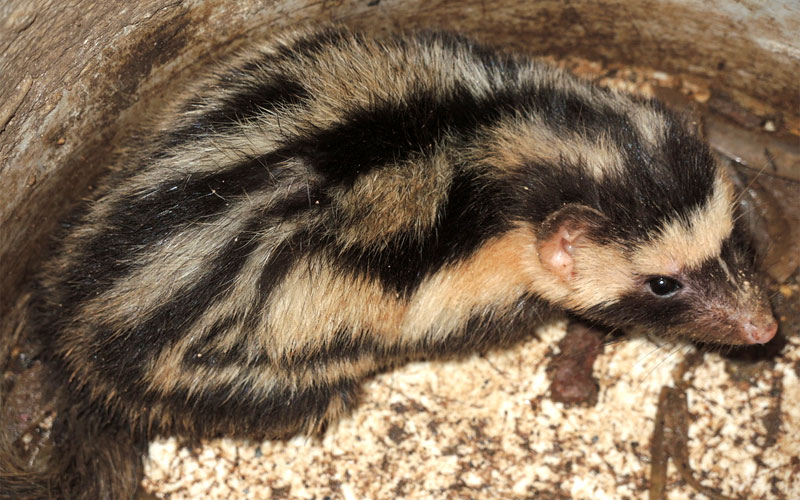
These small, weasel-like skunks can only be found on the western coast of Mexico. They’re currently considered a vulnerable species due to the encroachment of humans into their limited territory.
As with other spotted skunks, pygmy skunks can climb trees in search of food or a place to hide.
#7 – Southern Spotted Skunk (Spilogale angustifrons)
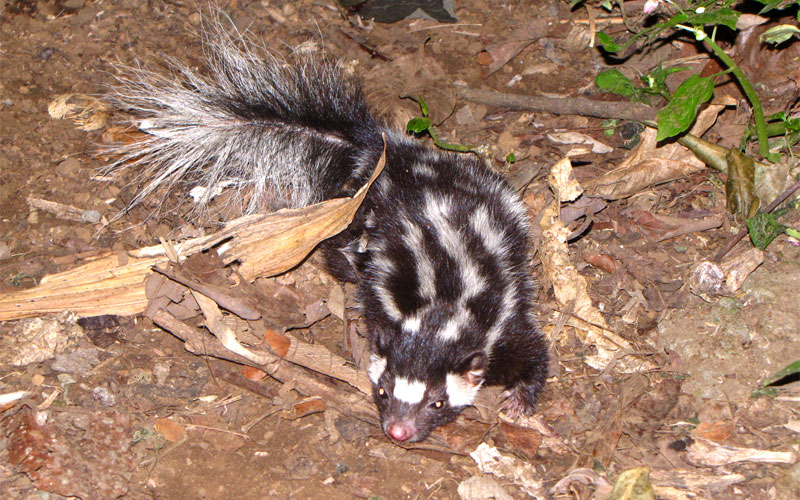
Found throughout Central America, this spotted skunk has a similar appearance to the western spotted skunk. It hunts primarily at night, often climbing trees in search of prey.
#8 – Striped Hog-Nosed Skunk (Conepatus semistriatus)
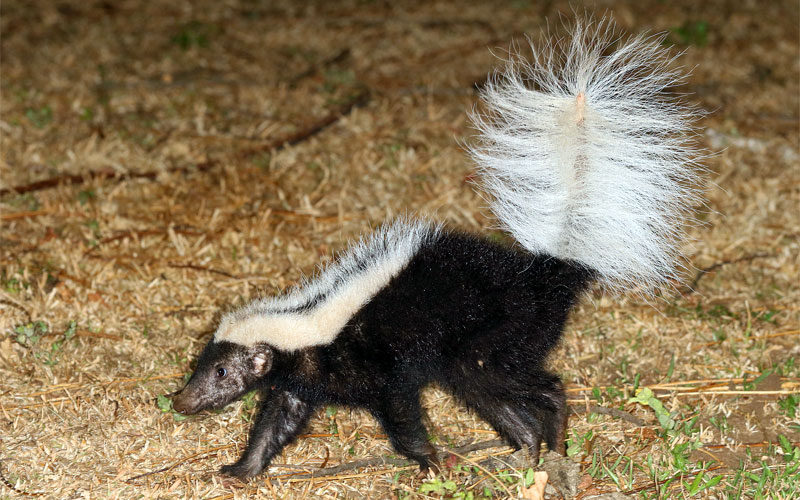
Striped hog-nosed skunks are a small species with a small habitat range. They have two stripes going partway down the back and meeting on the head. You’ll encounter them in parts of Central America, as well as the northern coast of South America heading westward to the northern part of Peru.
Oddly enough, there’s also an isolated population found in the easternmost portions of Brazil, hundreds of miles from other populations.
#9 – Striped Skunk (Mephitis mephitis)
When you think of skunks, this is most likely the species that comes to mind. Striped skunks can be found everywhere from Northern Mexico to Southern Canada and are highly adaptable.
Able to eat insects, rodents, small lizards, and even venomous snakes, these critters are an important part of the ecosystem, but in most cases, you’ll want to keep them out of your yard.
But for some, they happen to make great pets due to how sociable they are. Owning a skunk is legal in 17 states, although they must be de-sacked and usually registered. In the UK, it’s also legal to own a skunk, but illegal to de-sack one.
Striped skunks have two lighter stripes running down their back and tail and may sometimes have additional white markings. They’re quite intelligent and inquisitive, but also quite capable of defending themselves when threatened.
#10 – Western Spotted Skunk (Spilogale gracilis)
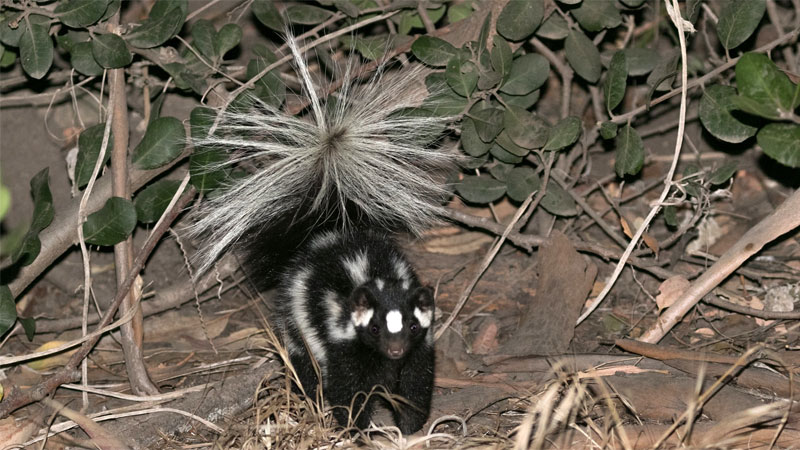
These skunks look as though someone was blending chocolate syrup into vanilla ice cream and decided to paint a skunk to match. The stripes tend to occur in threes and are found all over the skunk’s body.
They’re found in the western half of the US, northern Mexico, and southwestern Canada. Western spotted skunks not only eat berries, lizards, and small rodents; they also sometimes eat bees and wasps.
Honorable Mention: Stink Badgers (Mydaus spp.)
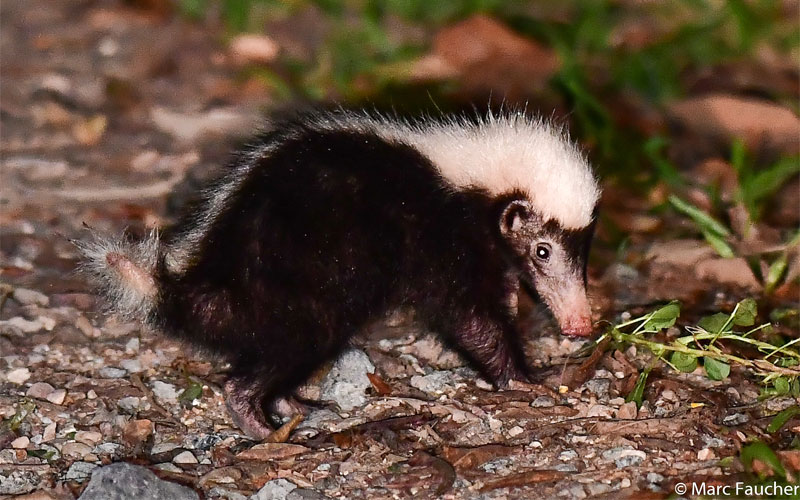
Stink badgers are neither badgers nor skunks, but are often considered honorary skunks because they’re close relatives and are part of the skunk family. Only two species of stink badger still exist.
The pantot (Mydaus marchei), or Palawan stink badger, is a carnivore from the western Philippines. Meanwhile, the teledu (Mydaus javanensis) is often referred to as the Sunda stink badger and may be found throughout much of the Sunda Islands.
This latter species also has a single thin white stripe down its back that make it look more like a skunk than its more badger-like sibling.
Common Skunk Attributes
Skunks are highly beneficial critters, but can also be annoying garden pests and (of course) can spray you or your pets. They’ll go after pet food, dumpster dive, and dig holes in your lawn. Worst of all, they’re potential carriers of rabies, although this is rare.
The well-developed claws on the forefeet of skunks are used for both digging and climbing. They’re not sharp enough to defend against natural predators, but skunks do have plenty of other defenses.
When threatened, they’ll make aggressive noises and stamp their back feet or even do a handstand. When playing or fighting, a skunk will fold its body in half so all weapons are facing the enemy.
Adult skunks aren’t the only ones who can spray. A newborn’s scent glands can produce that classic skunk odor before they’re old enough to see. A skunk’s musk supply is limited and must replenish. As a result, skunks often prefer to use their sharp teeth during a close fight and save their musk for a last resort.
Why the Type of Skunk Is Important
So now that we’ve looked at all of the skunk species out there, why is it important to know the difference? The biggest reason is legal in nature.
Even pet skunks are considered to be wild animals, and most species are protected by law to some degree. Thus, when you see skunk tracks, it’s important to keep an eye out and identify the species before attempting to trap or kill it.
In addition, most skunk species have a rather limited range with their own preference for food sources. Knowing which species you’re dealing with will allow you to perform a trap and release (if legal) using baits that are the most effective for that species.
Finally, skunks have poor eyesight but a really good sense of smell. Depending on the species, they might root for food or climb trees to hunt. Thus, knowing the species will help you figure out if you need to focus on looking up or down.
- How to Get Rid of Hawks - March 8, 2024
- How to Get Rid of Pill Bugs (Rolly Pollies) - March 1, 2024
- How to Get Rid of Groundhogs (Woodchucks) - February 5, 2024
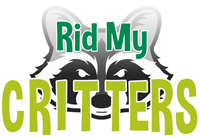
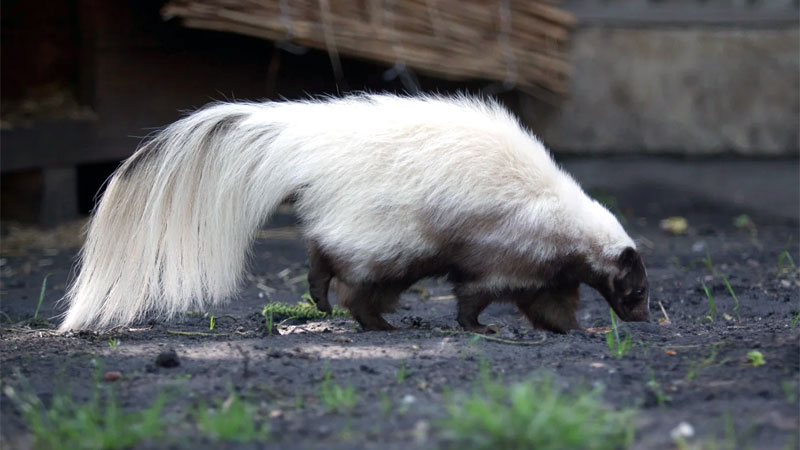
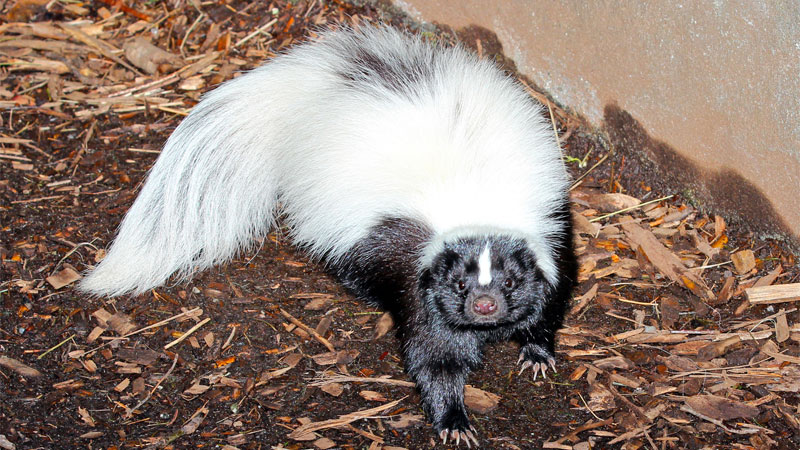
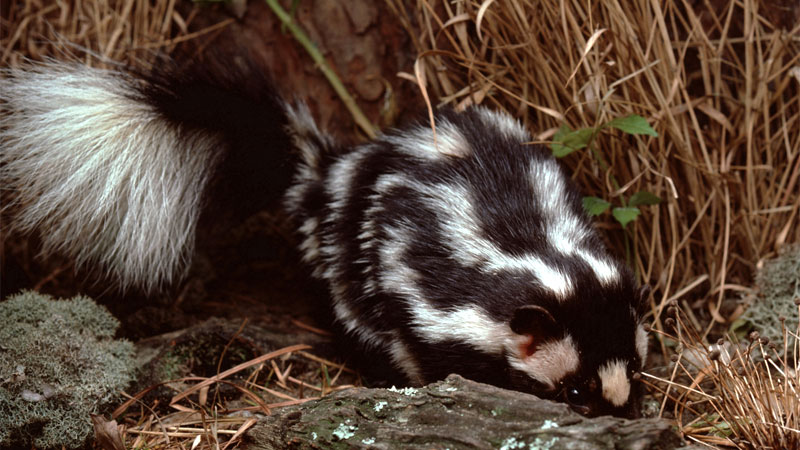
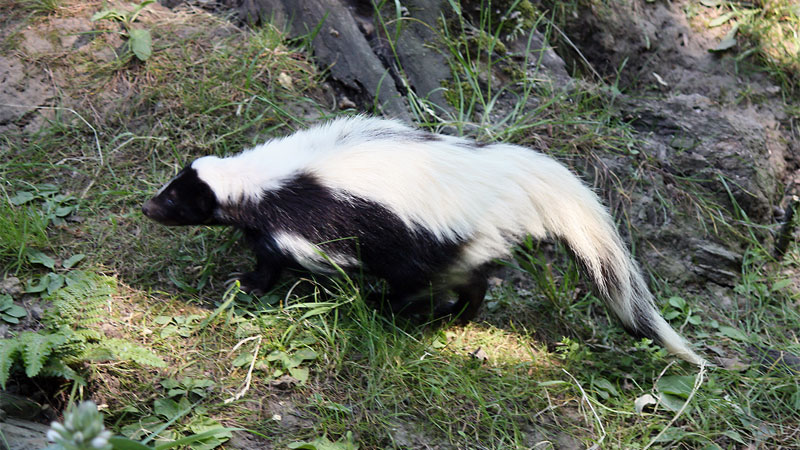
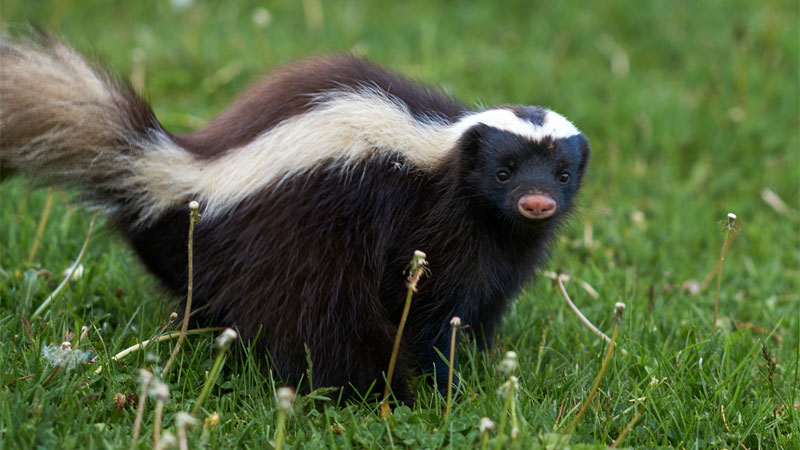
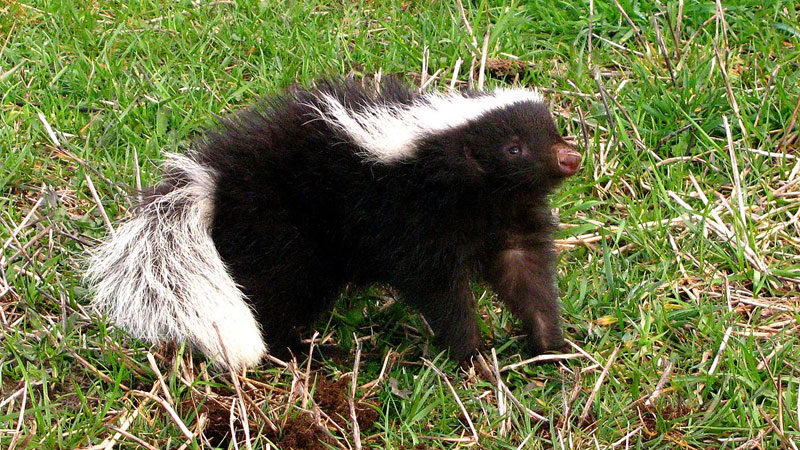

Hello,
Just wanted to let you know I visited your site to find out what kind of skunk we encountered recently. I do believe it was either the American Hog nose or the Hooded skunk you have listed. I got a pretty good look as it was right beside my house and spayed my male Husky multiple times. My brother next door has also encountered the same one over a year ago. Just thought I would let you know as both are stated to be in Southern US and Central America. But I reside in Monroe, North Carolina and have seen several varieties in our area.
It would be pretty unusual for one of those skunks to be found in NC (only spotted and striped skunks are native) but it is possible. They may have been accidentally relocated due to a natural disaster or a former pet skunk that someone kept. While not very likely, the possibility does exist that the species expanded their territory.